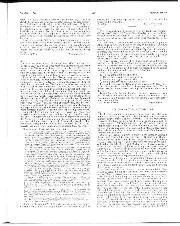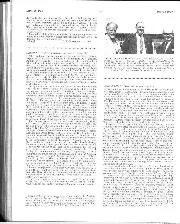

Lotus-Cortina reliability
Sir, In the first 12 months of owning one of these delightful automobiles, I covered 34,700 miles. Much of this mileage was done its this country, some of it on…
Jayson Fong
The premises, dominating the side of the M40 south of Banbury, say it all. Every vehicle in the car park points uniformly outwards while the sharp, angular and uncluttered lines of founder David Richards’ office are reflected throughout the building. Prodrive, which this year celebrates its 40th anniversary, is a company built on attention to detail.
The Prodrive name is prominent on the building but the company’s long-standing driver Darren Turner first thought it was a golf driving range. To date, the operation has been a ‘white label’ company, hidden behind brands like Subaru and Aston Martin while delivering World Rally Championships, Le Mans GT victories and British Touring Car Championships for its customers.
Richards reckons that Prodrive has been ‘silent’ about its projects. Having established itself as one of the UK’s foremost engineering concerns, it is about to “put our head above the parapet. We are going on an adventure to raise our profile with some of the other programmes that we are working on.”

Best known for its motor racing programmes, Prodrive has fingers in many tech pies, including aviation and marine
Jayson Fong
Prodrive may be known for taking Colin McRae, Richard Burns and Petter Solberg to rallying world championships or achieving class wins at La Sarthe for Ferrari and Aston Martin. However, while its partnership with vehicle manufacturers through its Advanced Technology and Composites divisions may be logical developments of its rallying origins, there is more to Prodrive, as can be seen in its Brand& operation sourcing clothing and accessories for clients that have ranged from McLaren to major football teams and the Olympic Games.
“The Impreza would become one of the greatest rally cars”
Richards came to prominence as a rally co-driver, navigating Ari Vatanen to the 1981 WRC title. An association with Rothmans led to the formation of his own team, initially with Castrol man Ian Parry. Forty years ago this became Prodrive, the aim of which was to enter a Porsche 959 in the WRC. This came to nought when the Group B cars were deemed too powerful for the series but, with a staff of 14 and a small workshop in Silverstone, Prodrive was on its way.
The longevity of much of Prodrive’s staff is often pointed out. One of those early employees was David Lapworth, now R&D director. Prodrive has become highly regarded as a training ground for engineers, with Lapworth now coaching for the future. Richards admits that his people may perhaps move on to the perceived glamour of Formula 1 but he is always ready to welcome them back to the fold.
Richards has experience of F1 having briefly run Benetton before using Prodrive’s strengths to turn round underperforming BAR. Jenson Button has fond memories of that time: “David made me realise what being part of a team meant and I think that was the real start of my career.”

The world’s lightest fold-up bike
It is rallying, particularly with Subarus, that Prodrive is best known for, as indicated by the amount of blue and yellow at the company’s 40th anniversary celebration in Banbury. Success came early with Saeed Al-Hajri taking the Middle East Rally Championship in 1984 in a Porsche 911 SC RS and then Bernard Béguin winning a round of the WRC, the 1987 Tour de Corse, driving a BMW M3. What Lapworth describes as “an important point in our history” came when Prodrive built its own derivative of the Porsche 959 to finish first on the 1985 Pharaohs Rally. It was, adds Lapworth, “our first real engineering project”.
The momentum built during its formative years led to an approach from Subaru, seeking to change its image. For 18 years, the Prodrive-run Legacies and Imprezas were to the fore of international rallying, taking three drivers’ and three manufacturers’ world titles, as well as winning 46 championship rounds. As a result, the distinctively liveried Imprezas would become one of the greatest ever rally cars.
When Subaru involvement ended, Prodrive proved its depth by designing a generic S2000 World Rally Car. Paul Doe, chief designer on the project, reckoned this to have been “one of [its] greatest experiences”. The work meant that Prodrive was able to slip back into world championship rallying when BMW approached it to bring the Mini name back into the sport. That project lasted a couple of years and would lead to involvement in rallycross. Having proved its prowess in conventional rallying, Prodrive was now branching out into other forms of off-road racing including the Extreme E series, which it won in 2022 with Lewis Hamilton’s X44 team.

Prodrive expertise is helping Dacia’s Dakar dream take flight.
Significant has been its focus on rally-raids and in particular the Dakar Rally. This, as team principal Gus Beteli points out, has been “a 100% Prodrive programme” making it all the more impressive that it has finished on the podium three years in a row with Sébastien Loeb driving its own creation, the Hunter. This year it was announced that Dacia had chosen Prodrive to develop and run a version of its Sandrider to compete in the World Rally-Raid Championship. With a major manufacturer now behind it, Prodrive is looking to achieve one of the two major trophies that have so far eluded it. The other could be said to be outright victory at Le Mans; there is no doubt that Richards sees both as unfinished business.

Beating Corvette with a Ferrari 550 to the GTS class win, Le Mans, 2003
Prodrive’s move into circuit racing dates back to its success in rallying with the BMW M3. This led to Frank Sytner suggesting a programme in the British Touring Car Championship, which resulted in the Nottingham car dealer winning the title in 1988. A leading player in the BTCC, Prodrive went on to run teams for Alfa Romeo, Honda and Ford. Over a 10-year period, it would win three drivers’ and three manufacturers’ titles. It was not a bad record for an operation that Sytner’s service manager had protested was only into rallying.
“A Prodrive-run Ferrari beat the might of Corvette at Le Mans”
The next step was endurance racing. Frédéric Dor, who had rallied an Impreza, approached Prodrive to run a Ferrari 550 Maranello in 2001. The expertise at Banbury meant that the transition from touring cars to GTs was seamless and, in 2003, a Prodrive-run Ferrari beat the might of Corvette to win the LMGTS class at Le Mans. This would lead to its connection with Aston Martin. The first fruits of this partnership, the DBR9, won its class in, as Darren Turner points out, Corvette’s “back garden” – Sebring, in 2005. That meant expectations were high for Le Mans. Despite an impressive performance, the DBR9s would not win that year. However, two years later, Turner, partnered by David Brabham and Rickard Rydell, finished first in class. There would be more wins at La Sarthe, in the World Endurance Championship and elsewhere for Prodrive-supported Aston Martins. At the beginning of 2024, Beteli estimated that the company would be giving engineering support to more than 30 customers.

Impreza tribute Prodrive P25
As for winning the Le Mans 24 Hours outright, Richards reckons that current regulations create a number of possibilities. A start was made with the Lola B08/60-based Aston Martin prototypes. This was in the time of the diesels and the highest that these could achieve at Le Mans was a ‘best of the rest’ in 2009, although two victories elsewhere did result in the overall Le Mans Series title. For 2011, Prodrive created its own Aston Martin LMP. Neither car lasted more than four laps at Le Mans. It was a rare failure and the project was shelved; but you wouldn’t bet against Richards achieving a future victory.
There is now far more to Prodrive than sporting success. It is working more with aviation, the mainstream automotive industry and defence while developing its own projects such as a lightweight folding bicycle and the racing simulator designed by long-time Prodrive collaborator Peter Stevens. The company has also become a vehicle maker in its own right as can be seen with the P25, a modern interpretation of the Impreza WRC97 – moving forward while acknowledging its past.

Forty years on from the founding of Prodrive, David Richards remains driven for more major trophies, including Le Mans

For Subaru, its foray into WRC with Prodrive at the helm was a canny business decision, raising its profile from farmer’s friend to cult brand. Everyone wanted an Impreza; and still do – Prodrive’s half-a-million-quid P25 tribute to the 22B STI, which wowed journalists on its launch in 2023, is testament to that. Allied with Subaru’s blue/gold livery the Impreza epitomises Prodrive’s sporting prowess. It was included in Motor Sport’s Race Car of the Century shortlist earlier this year.

From nearest: DBR9, 2007 Le Mans class winner; Ari Vatenen/David Richards 1981 WRC Escort; BMW E30 M3
Jayson Fong
Prodrive already had sports car experience following a class win at Le Mans in 2003 with a re-engineered Ferrari 550 Maranello. Aston Martin was the next endurance customer; its DBR9s began a run of unprecedented sustained racing success for Aston Martin that continues today. The DBR9 was instantly competitive, taking a class win in its first outing – the 2005 Sebring 12 Hours. Its battles with Corvette and back-to-back class wins at Le Mans in 2007 and ’08 elevated the carmaker.

Prior to the Imprezas impressing in WRC, Prodrive made its name in the BTCC, starting in 1987 overseeing BMW’s entry. Frank Sytner joined Prodrive that year and the results were immediate, with three podiums, including a victory, in his first five races. The following year, Sytner was BTCC champion and David Richards’ winning culture was in full swing. Prodrive went on to take Class B titles in 1989 and ’90 before running programmes for Alfa Romeo, Honda and Ford.

Banbury might be as far removed from the Saudi desert as is possible, yet the Prodrive Hunter has been devouring Dakar’s dunes – in January’s edition, Sébastien Loeb and Nasser Al-Attiyah gave chase to Audi’s Carlos Sainz but ultimately were unable to match the Spaniard. Even so, Prodrive regards the Dakar and World Rally Raid Championship as it’s greatest test. There’s more to come…